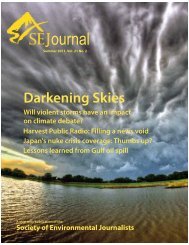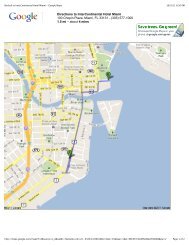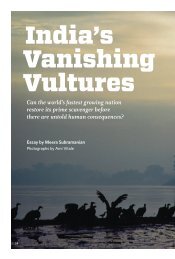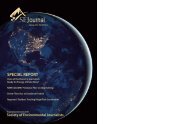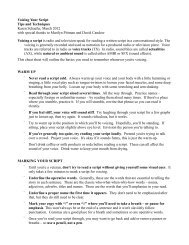PDF Download - Society of Environmental Journalists
PDF Download - Society of Environmental Journalists
PDF Download - Society of Environmental Journalists
Create successful ePaper yourself
Turn your PDF publications into a flip-book with our unique Google optimized e-Paper software.
SEJ NewsSEJ Event at ASU examines online reporting opportunitiesBy CAROLYN WHETZELPrint journalists considering a dive into Web-based mediashould, at the very least, start a blog. Even better, develop thetechnical skills needed for multimedia reporting.That advice comes from Dan Gillmor, director <strong>of</strong> the KnightCenter for Digital Media Entrepreneurship at Arizona StateUniversity’s Walter Cronkite School <strong>of</strong> Journalism and MassCommunication.Gillmor was one <strong>of</strong> four veteran newspaper journalists whotalked about the opportunities for quality journalism, includingenvironmental reporting, in online news outlets at a program SEJsponsored Jan. 30 at the Cronkite School in downtown Phoenix.“Learning about being on the Web and digital (media) formsis about just doing it,” Gillmor said. The chances for financialsuccess are best “if you can find a niche and go deep and be thebest at it in the world and have a market” Gillmor said.As a columnist at the San Jose Mercury News, Gillmor, in1999, launched one <strong>of</strong> the first weblogs from within a traditionalnews organization.“Internet-based news sites, even those operated by traditionalnewspapers, are capturing large audiences,” Gillmor said. Manyrely on the news that other organizations are paying to produceand are unlikely to support what Gillmor called “eat your spinachjournalism,” the kind <strong>of</strong> good journalism SEJ promotes and thetype <strong>of</strong> reporting a growing number <strong>of</strong> newspapers are unable t<strong>of</strong>inance, he said.But new models are emerging, including non-pr<strong>of</strong>it newsoutlets like ProPublica, that are supporting quality, originaljournalism, and innovative multimedia news sites, Gillmor said.Other journalists on the panel —Adam Klawonn, editor andpublisher, The Zonie Report; Marla Cone, editor-in-chief,<strong>Environmental</strong> Health News and former SEJ board member; andDouglas Fischer, editor, The Daily Climate — shared the motivesbehind their move to online news.After The Arizona Republic shuttered its news bureaus aroundthe state, Klawonn saw an opportunity for a multimedia statewidenews site. Klawonn left San Diego to return to his native state, andwith money he had squirreled away for graduate school, launchedThe Zonie Report.The Zonie Report does not provide breaking news, he said.Instead, it focuses on five topics: growth and development,environment, health, politics, and Mexico.“These are the five things people really care about,” saidKlawonn, the site’s editor and publisher.Klawonn’s site features blogs, narrative, video, and sound,much <strong>of</strong> it produced by him and freelancers. While popular, thefree site has yet to generate enough advertising revenue or otherincome to be self-supporting.As a result, Klawonn works as editor at Phoenix magazine andas an adjunct pr<strong>of</strong>essor at ASU’s Cronkite School.Marla Cone spent 18 years as an environment writer at theLos Angeles Times pioneering a beat that focused on explainingthe risks pollutants pose to the public health, wildlife, and ecosystems.“I’m very much an old media person,” Cone said. “I'veworked at newspapers for 30 years.”Quarterly downsizings at the Los Angeles Times had cut theeditorial staff in half and curbed the ability to write long stories, shesaid.“I didn’t think we were serving the readership” Cone said. “Iwant to write about things people should know about.”'Last fall, she accepted the job at <strong>Environmental</strong> Health News,a non-pr<strong>of</strong>it online news outlet published by Charlottesville,Va.-based <strong>Environmental</strong> Health Sciences.“We’re the ProPublica <strong>of</strong> environmental news,” Coneexplained.EHN’s researchers gather news and science from around theglobe daily. Its free daily e-letter, Above the Fold, is <strong>of</strong>ten the firstthing many environmental journalists look at in the morning. ButEHS also provides original reporting by staff and freelancers thatit syndicates to other publishers for free.“I’m writing the same type <strong>of</strong> stories I used to write at the LATimes,” Cone said. “We're filling the void for newspapers that can’tsupport this kind <strong>of</strong> journalism any more.”Fischer said his move to The Daily Climate, alsoanEHSpublication, is giving him a chance to help reinvent journalism, acareer he was beginning to question.The turning point came when Fischer’s wife accepted afellowship in Boulder, Colo., forcing his departure from theOakland Tribune and a search for new work.Fischer said he starts the work day at 5 a.m., reviewingclimate change-related news stories and other information EHSresearchers dump into his queue to determine which to add thewebsite.Both Fischer and Cone have healthy budgets for freelancestories, courtesy <strong>of</strong> foundation grants that have absolutely no sayin the editorial content <strong>of</strong> the stories.Carolyn Whetzel is California correspondent for BNA and alongtime SEJ board member.7 SEJournal Spring 2009



